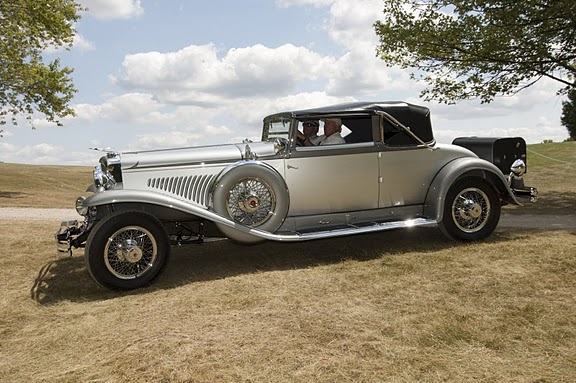Indiana-built Full Classics: Legends of quality and performance
Some of the most beautiful, prestigious and valuable cars designated as Full Classics by the Classic Car Club of America were produced in Indiana between 1925 and 1937. Committed to quality and passionate about performance, the Hoosier state automakers discussed here left behind an exceptional legacy.
Few Indiana-built cars are more renowned than the Full Classic Auburn,* Cord and Duesenberg models produced under the control of super-entrepreneur Errett Loban Cord (1894-1974). Those trendsetting and stylish automobiles combined exceptional performance with a grand panache that still delights enthusiasts.
Founded in 1900 and named after the Indiana town where it was headquartered, the Auburn Automobile Co. became the cornerstone of E. L. Cord’s automotive aspirations after coming under his direction in 1925. That same year, the inline-eight cylinder models destined to become the earliest Full Classic Auburns were introduced. The original version of Auburn’s famed boat-tail speedster followed in 1927. All 1925-1936 Auburn Eights and the fabulous Auburn Twelves of 1932-1934 are accredited Full Classics.
In 1926, E. L. Cord added Indianapolis-based Duesenberg, Inc. to the roster of companies under his domain. Highly respected as builders of racing cars and engines, brothers Fred and August Duesenberg first offered the expensive and powerful Duesenberg automobile in 1921. Cord gave them carte blanche to create for him a new Duesenberg super car of incontestable prestige and unmatched performance. The resulting Model J Duesenberg of 1928 was in every respect “America’s Mightiest Motorcar.” Massive and breathtakingly fast, the ultra-exclusive “Duesey” was quickly embraced by the world’s elite. Fewer than 500 Duesenberg Model J and SJ (supercharged) cars were built.
Basking in the American prosperity of the late 1920s, E. L. Cord next decided to introduce an exciting and innovative high-performance luxury car bearing his own name. Two distinct series of Cord automobiles were built — both pioneering front-wheel-drive designs. Dramatically long and low, the straight-eight powered Cord L-29s of 1930-32 were completed in Auburn, while the wonderfully svelte and sporty V-8-powered 810/812 Cords of 1936-37 were assembled in Connersville. Every 1930s Cord is a Full Classic, and it takes but a single glance at one to understand why.
By 1936, E. L. Cord’s interest in automobile manufacturing was waning. Auburn production was shut down that year, and before 1937 was out, Duesenberg and Cord were also gone.
The Indianapolis-built Stutz* was famed for its racy Bearcat sports models long before the Classic Era began. The nameplate’s illustrious performance heritage dated to the first running of the legendary Indianapolis 500 in 1911. Full Classic Stutz models include the DV-32, with its four valves per cylinder eight-cylinder engine, and the exceedingly rare short-wheelbase Super Bearcat of 1932-1933. During 1929-1930, Stutz marketed the Blackhawk, a smaller, less costly, but still high-performance “companion car” that also has been afforded Full Classic status. Stutz and Blackhawk sports models raced at Le Mans in the late 1920s. Even now, the gracefully athletic lines of the Classic Stutz and Blackhawk make them automotive standouts.
An automotive paragon of engineering excellence, the Marmon* was produced in Indianapolis from 1902 to 1933. Counted among the most prestigious of Full Classics, the magnificent Marmon V-16s of 1932-33 are prized both for their superb engineering and machine-age design elegance. Certain earlier Marmon models produced between 1925 and 1931 are also embraced by the CCCA.
Ranking as Indiana’s most prolific automaker, Studebaker* was founded in 1852 and built horse-drawn wagons for the Union Army during the Civil War. By the 1920s, the South Bend-based firm was producing stalwart medium-priced automobiles for a dedicated customer base. During 1928-1933, Studebaker’s top-line eight-cylinder models were especially fast and luxurious automobiles — and it is those cars that now enjoy CCCA Classic status.
Our final three Indiana builders of Full Classics produced cars that are little known today.
Large in size and price, the ornate and lavishly appointed McFarlan was handcrafted at Connersville for silent film stars and other notables before calling it a wrap in 1928.
The Elkhart-based Elcar,* produced between 1916 and 1933, roared into the Classic era in 1925 with a new premier line of eight-cylinder models. Later, Elcar became involved in a doomed attempt to revive the famed but dormant Mercer automobile. In 1930, Elcar constructed a prototype Mercer convertible and a show chassis for the ill-fated Mercer Motors Corp.
Launched at Logansport in 1917, the Revere was a fine car that was already fading away by the dawn of the Classic era. The final Revere models featured an unusual double steering wheel parking aid device. Although the CCCA grants 1925-1926 Reveres Full Classic status, none are listed in the club roster.
*See CCCA Approved Classics list for specific year and model eligibility.


